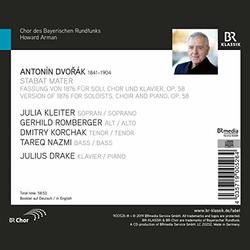| All Artists: Julia Kleiter, Gerhild Romberger, Dmitry Korchak, Tareq Nazmi, Julius Drake Title: Stabat Mater Members Wishing: 0 Total Copies: 0 Label: Br Klassiks Release Date: 10/4/2019 Genre: Opera & Classical Vocal Style: Number of Discs: 1 SwapaCD Credits: 1 |
Search - Julia Kleiter, Gerhild Romberger, Dmitry Korchak :: Stabat Mater
 | Julia Kleiter, Gerhild Romberger, Dmitry Korchak Stabat Mater Genre: Opera & Classical Vocal The Stabat mater by the Bohemian composer Antonin Dvorák, well-known in its later orchestral version, was initially composed with piano accompaniment. This rarely-heard original version has now been recorded for BR-KL... more » |
Larger Image |
CD Details
Synopsis
Product Description
The Stabat mater by the Bohemian composer Antonin Dvorák, well-known in its later orchestral version, was initially composed with piano accompaniment. This rarely-heard original version has now been recorded for BR-KLASSIK, featuring the excellent Bavarian Radio Chorus under the direction of Howard Arman, and accompanied by Julius Drake on the piano. The young Dvorák was a well-studied and experienced church musician. Having graduated from the organ school in Prague, he spent three pious years as an organist in the citys St. Adalberts Church. The search for a truly sacred music preoccupied him from the very start. The contemporary Caecilian Movement for church music reform led him, like many of his colleagues, to re-examine the Palestrina style, which represented a return to the more modest, less ostentatious and yet at the same time contrapuntally ingenious church music of a previous epoch. He duly composed a Stabat mater without orchestral splendour and with a simple piano accompaniment. Shortly before Dvorák wrote down this first version of his Stabat mater between February 19 and May 7, 1876, a heavy blow had struck the young family. On December 19, 1875, his daughter Josefa died two days after she was born. Dvorák did not set all the verses of the hymn to music, and chose an ensemble of four soloists, a choir and a piano. This original version from the spring of 1876, with its seven-movement structure, is not a fragment, draft or piano reduction but an independent and self-contained work in its own right. In the autumn of 1877, when he composed the missing four verses and scored his Stabat mater for a large orchestra, he effectively created a new and different work.
